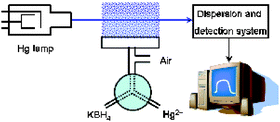Direct detection of mercury in vapor and aerosol from chemical atomization and nebulization at ambient temperature: exploiting the flame atomic absorption spectrometer
Abstract
A Y-shaped Teflon connector was designed to branch the capillary of a conventional commercial flame


 Please wait while we load your content...
Please wait while we load your content...